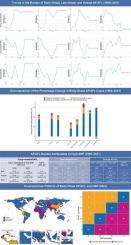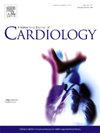早发性心房颤动和扑动的全球负担:基于人群的研究。
IF 3.2
2区 医学
Q2 CARDIAC & CARDIOVASCULAR SYSTEMS
引用次数: 0
摘要
背景:心房颤动和扑动(AF/AFL)传统上被认为是老龄化疾病,大多数研究集中在老年人身上。方法:使用全球疾病负担2021研究的数据,我们分析了1990年至2021年30-64岁 人群中AF/AFL的患病率、发病率、残疾调整生命年(DALYs)、死亡率和平均年百分比变化(AAPC)的趋势。Das Gupta分解量化了人口增长、老龄化和特定年龄患病率的贡献。基于与心肌病和心肌炎(CMP)的空间共发性,我们将204个国家和地区分为一致型、AF/ afl型和CMP型。结果:从1990年到2021年,早发性AF/AFL的年龄标准化患病率、发病率和DALY率显著增加(AAPC分别为0.14 %、0.11 %和0.07 %),与晚发性AF/AFL或整体AF/AFL人群的稳定趋势不同。人口增长占早发病例增加的89% %,其次是老龄化(17% %)和年龄特异性患病率上升(7% %)。高收缩压是主要危险因素,每10万人贡献13.04 DALYs (AAPC: 0.09 %)。2021年,86个国家表现出一致的模式,65个国家以cmp为主,53个国家以AF/ afl为主。结论:早发性AF/AFL的全球负担在过去三十年中显著上升,与晚发性或总体人群的稳定趋势形成对比。这些发现主要受人口增长和高收缩压的驱动,并与心肌病有关,强调了针对特定年龄的策略和有针对性的研究的必要性。本文章由计算机程序翻译,如有差异,请以英文原文为准。

Global burden of early-onset atrial fibrillation and flutter: Population based study
Background
Atrial fibrillation and flutter (AF/AFL) are traditionally regarded as diseases of ageing, with most research focused on elderly populations. In contrast, early-onset AF/AFL (<65 years) is increasingly recognized as a potential marker of cardiomyopathy, yet its global burden remains poorly understood.
Methods
Using data from the Global Burden of Disease 2021 study, we analyzed trends in prevalence, incidence, disability-adjusted life years (DALYs), mortality, and average annual percentage change (AAPC) of AF/AFL among individuals aged 30–64 years from 1990 to 2021. Das Gupta decomposition quantified the contributions of population growth, ageing, and age-specific prevalence. Based on spatial co-occurrence with cardiomyopathy and myocarditis (CMP), we classified 204 countries and territories into consistent, AF/AFL-dominant, and CMP-dominant patterns.
Results
From 1990 to 2021, age standardised prevalence, incidence, and DALY rates of early-onset AF/AFL increased significantly (AAPC: 0.14 %, 0.11 %, and 0.07 %, respectively), unlike the stable trends observed in the late-onset or overall AF/AFL population. Population growth contributed 89 % of the increase in early-onset cases, followed by ageing (17 %) and rising age-specific prevalence (7 %). High systolic blood pressure was the leading risk factor, contributing 13.04 DALYs per 100,000 population (AAPC: 0.09 %). In 2021, 86 countries showed consistent patterns, 65 were CMP-dominant, and 53 were AF/AFL-dominant.
Conclusions
The global burden of early-onset AF/AFL has risen significantly over three decades, contrasting with stable trends in the late-onset or overall population. Driven mainly by population growth and high systolic blood pressure, and linked with cardiomyopathy, these findings underscore the need for age-specific strategies and targeted research.
求助全文
通过发布文献求助,成功后即可免费获取论文全文。
去求助
来源期刊

International journal of cardiology
医学-心血管系统
CiteScore
6.80
自引率
5.70%
发文量
758
审稿时长
44 days
期刊介绍:
The International Journal of Cardiology is devoted to cardiology in the broadest sense. Both basic research and clinical papers can be submitted. The journal serves the interest of both practicing clinicians and researchers.
In addition to original papers, we are launching a range of new manuscript types, including Consensus and Position Papers, Systematic Reviews, Meta-analyses, and Short communications. Case reports are no longer acceptable. Controversial techniques, issues on health policy and social medicine are discussed and serve as useful tools for encouraging debate.
 求助内容:
求助内容: 应助结果提醒方式:
应助结果提醒方式:


